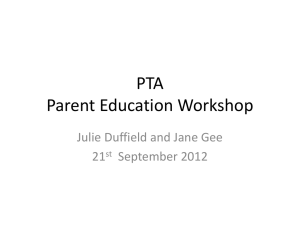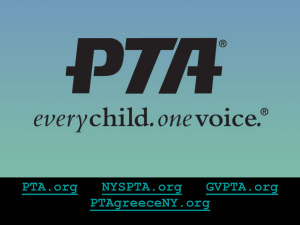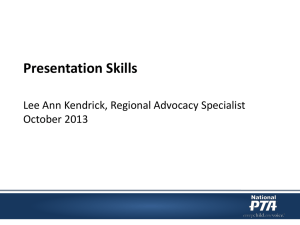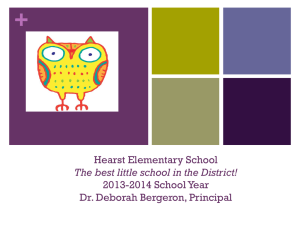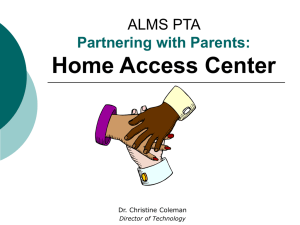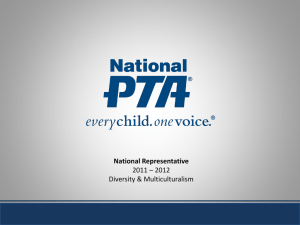Ethics - mccpta
advertisement
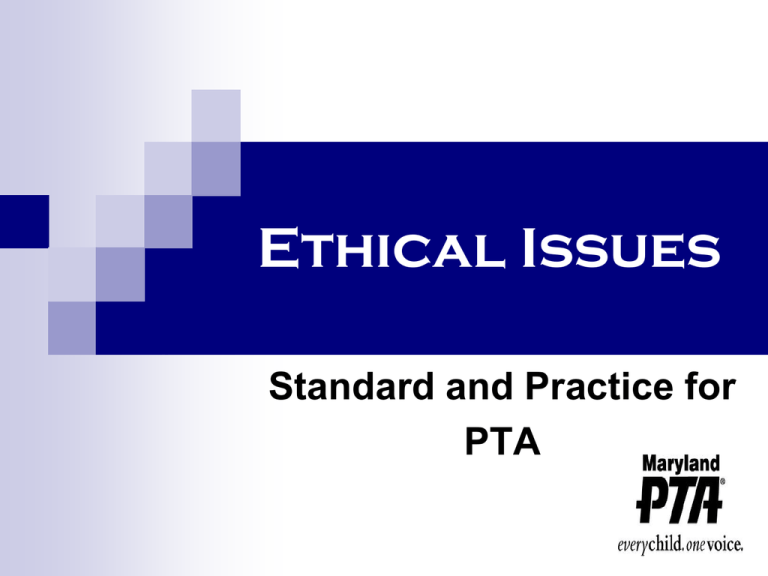
Ethical Issues Standard and Practice for PTA Definition: Merriam-Webster eth·ic noun \ˈe-thik\ Definition of ETHIC 1 plural but sing or plural in constr : the discipline dealing with what is good and bad and with moral duty and obligation 2 a : a set of moral principles : a theory or system of moral values <the present-day materialistic ethic> <an old-fashioned work ethic> —often used in plural but singular or plural in construction <an elaborate ethics> <Christian ethics> b plural but sing or plural in constr : the principles of conduct governing an individual or a group <professional ethics> c : a guiding philosophy d : a consciousness of moral importance <forge a conservation ethic> 3 plural : a set of moral issues or aspects (as rightness) <debated the ethics of human cloning> Ethics: Ethics is a topic that is very immense and can not be fully explored in this presentation. The intention of this program is to give guidance from Maryland PTA to Local and County PTA. For more study on the subject: National PTA website www.pta.org has e-learning course’s under Leadership Fundamental’s programs include ethics and other topics covered in this presentation. Ethics Continued: “All local boards have enacted local ethics provisions pursuant to the requirements of State Government Article Sections 15-811 -- 15-815 and State Ethics Commission regulations at COMAR 19A.05.” Therefore, your Local Education Agency (LEA) has in place a policy or code for you to review please search their website or ask the appropriate personnel. Maryland State Ethics Commission http://ethics.gov.state.md.us/ also has posted codes of conduct. Regulations are listed that each LEA is required to incorporate into their policies as well as in practice. A Few Key Ethical Principles Explored: Honesty Transparency Respect for the Individual Integrity Tolerance Conflict of interest Beneficence Non-maleficence Common Good Honesty: Be factual about programs supported by the PTA. Do not give less than accurate facts in order to gain support from the board and members for a program or event that you are passionate about. Don’t give half truths if the members are expecting to have an event that has occurred for years but there is not the money or the leader to run it let the membership know that it can’t happen this year unless these are in place. Dishonesty will quickly tarnish the reputation of the PTA and its leadership. Transparency: Be open about the mission and goals of the PTA. Post these at meetings, read them aloud, or even post them on your web site. Make documents and information available and accessible to members including: audits, reports, budget, fundraising objectives... By law your 990 is to be available to the public but do more to inform membership and others about the association. Fundraising should clearly articulate the mission, goals, activities/events it supports, and revenue. Respect: Respect for each individual: Includes Student, Non-Member, Member, Volunteer, Committee Chair, Officers of the Association, School Staff and Administration. Inclusiveness Dignity Autonomy Stewardship Subsidiarity Respect continued: Inclusiveness – Do not exclude any person from PTA membership or volunteerism. Accept differences. Dignity – Treat all individuals the way you would like to be treated. Autonomy – PTA is Volunteer based, individuals have the right to say “no”. Do not assume that all are in agreement – follow Robert’s Rules of Order for discussion. Stewardship – Responsibilities for the care of the organization and all of its membership. Subsidiarity – Those in authority (the board) recognize that individuals (membership) have the right to participate in decision making that will directly effect them (for example approval of the budget) Integrity: Actions along with written and spoken words that positively reflect the association. Maintain a personal Code of Ethics. Having a written expectation of behavior does no good if it is not adhered to by all. Leaders of the association set the stage for actual ethical behavior – set a good example, “the buck stops here”. Tolerance: Give people and their differences room to breathe - you don’t need to agree but agree to disagree. Don’t need to be BFF’s to do good work for the association. Please leave your own agenda at the door so others can do the same. Cultivate a Board of Directors that reflects the community it serves. Conflict of Interest: No one person is to profit from the association. Do not join the PTA Board to gain customers for your business, to gain membership contact lists, to promote yourself financially (employment) and or politically (run for office after your term is up or resign your position). Bylaws provide basic rules to guide the association. If there is an action item to be taken and you have a personal conflict of interest declare it and recuse yourself from the vote and or discussion. Beneficence: To do good and avoid doing wrong. When making decisions there may be “shades of grey” where it is difficult to see the best possible choice include the entire board in these decisions and the entire membership when able. Use Robert’s Rules of Order to guide discussion to enable all to speak and be heard. The majority rules when voting on actions of the association. Non-maleficence: To first do no harm. Sometimes in decision making a choice may have adverse effects. If the board is considering an action but a negative impact is detected that is considered harmful to the association or its members then the decision should be no action taken. Common Good: Decision making that is done for the greatest good of all membership. Sometimes there are members who do not contribute equally decisions should not be made that only have positive outcomes for those who volunteer or hold specific positions within the association. When working on the behalf of the association its goals, mission, objectives supersede that of the individual. Non-profit Management: Specific IRS Guidelines Activity directly reflects the mission and vision Financial assets belong to the association Documentation is the property of the nonprofit Volunteers: Volunteers lead the association and therefore… there is no payment for service either monetary or in kind there is fiscal responsibility there is confidentiality and professionalism there are expectations and accountability Volunteers as Professionals: Knowledgeable – Speak with authority Articulate – Use proper language Presence – Non-verbal positive regard Appearance – Dress for success Procedure: Parliamentary Procedure/ Roberts Rules of Order Offer guidance in order to conduct meaningful business Provide an opportunity for every voice to be heard Confirm leadership positions and members rights/responsibilities Roberts Rules are not… Weapons Bullying Tactics Delay or Filibuster strategies Dictator development tools Suppressors Exclusionary Tactics Conflict Exchanges of ideas create conflict Conflict is a way of opening the door to new ideas and points of view It is an opportunity to explore new solutions to problems It offers new approaches to cooperation, collaboration and communication Unity: All board members share the same message Discussion and disagreement take place within the meeting (not the parking lot) The final decisions of the board are the decisions of each board member The whole is greater than the sum of its parts Difficult Situations: Appreciate extenuating circumstances and situations Accept that someone may not always be at their best Acknowledge the belief that no one is perfect including you. Recognize your own frustrations and how you handle them. Fundraising and Ethics: Accountability to Donor Respecting Donor Intent Be Honest in Disclosure Donor demands Acknowledging Donations 3:1 rule Accountability to Fundraising Donor: What is the fundraiser for? Please list your fundraising goals specifically. “The sale…will be used to provide a back to school ice cream social, awards for our Reflections participants…” Where will the funds be used? List and state clearly the goals, objectives, plans, events, and programs of your PTA and let all know that this is what funds raised supports – detail. When/How will the funds be utilized? If the funds are being saved for a long term goal let members know. Respecting Donor Intent: If the PTA receives a donation with a specific intent listed or a “restricted gift”, that is the intention and should be utilized only for that reason. If the gift’s intention is in conflict with the association’s goals/mission then it should be returned to the donor. Be Honest in Disclosure: Be honest in disclosure of a fundraising purpose prior to the fundraiser solicitation. Let membership know the reasons for fundraising – transparency. If the purpose changes then let the membership know and be part of the decision via a general membership meeting. Donor Demands: What if a person is donating funds to the organization and is making demands that are unreasonable or not given to other members? This may be difficult and may require a decision by the Board of Director’s on each individual situation balancing the pros and cons. What if a person is donating restricted funds to the association but the purpose is in conflict with the associations mission and goals? The PTA Mission is clearly stated and no action can be taken in conflict with National PTA or Maryland PTA Policy. County Council and Local Bylaws also provide governing rules to guide in decision making. Acknowledging Donations: Say “Thank you” for donations of time, treasure, and talent. Send a thank you card. Place a thank you message to membership in the PTA Newsletter for supporting fundraising efforts, volunteering,... Acknowledge non-financial donations sponsor a volunteer appreciation day. 3:1 Rule of Fundraising As a general rule provide three events or programs for each fundraiser. If the members feel that something is needed for the students but it is absolutely something that should be provided for in the school budget try advocacy to procure the resource instead of creating another fundraiser. Don’t fundraise just for the sake of fundraising. Insurance and Liability Call BB&T Insurance for questions Review the Insurance guide The Board of Director’s is responsible for decisions taken Don’t make decisions for the board that will follow Only President signs contracts Two signatures on checks When in doubt ask… Insurance When a local PTA sponsors any event or activity, it must comply with its current insurance policy coverage. All PTA units in Maryland are required to have insurance coverage of: Liability Bonding Directors and officers Insurance Continued The Maryland PTA negotiated insurance policy is through BB&T Insurance Services. The insurance carrier information: BB&T Insurance Services of California, Inc. 535 N. Brand Blvd., 10th Floor Glendale, CA 91203 For questions or enrollment at any time, please call BB&T Insurance Services of California, Inc., 818-662-4202 or mdpta@bbandt.com. Toll free: 866-611-9400 Insurance - Liability Before planning any PTA activities, the RED, YELLOW, and GREEN pages be reviewed in the insurance guide. For the insurance loss and prevention guide, go to the Maryland PTA website www.mdpta.org click on insurance and scroll down the page click on the “Loss Control Guide Book 2012 Maryland PTA” Communication: Presentation and Perception Newsletters Email Social Media Presentation and Perception: How you conduct yourself directly reflects on PTA Your manners, behavior and conversation reflect not only on you as a person but also as a leader in PTA Remember that you represent the image, integrity, and ideals of PTA Newsletters: Communicate goals and mission of the PTA with all members and non-members. Give progress updates on goals, events, and programs. Solicit for volunteers in a respectful and friendly manner. Welcome all volunteers and members. Try to include non-members and ask them to join. Celebrate success via announcements and congratulations. Email: Email Etiquette Email Usage Email Clarity Email Respect Email Responses Email Consideration Email Messages Email Etiquette: Email has revolutionized communication by utilizing the worldwide web. Email is useful to share information, not emotion. Online traces exist which allow others to view your online activity. What you say reflects your personal values, attributes, intellect, and professional decorum Email Usage: If your name appears in the: TO: You are being addressed, please respond. CC: FYI. You can respond but only if it is of the utmost importance. BCC: Use this feature when you want to protect someone’s e-mail address privacy Email Clarity: When using RE: , be very specific. If it says “confidential”, it stays between the sender and receiver. “!!!” means the message is very important. If it is time sensitive, you can also put that in the subject line. Use the subject line to assure receipt and importance Email Respect: No one word responses. (Yikes, wow, good) No more that 3 reply trailers, so the e-mail does not go on and on and on and on. Remember that humor, like beauty is in the eye of the beholder Email Responses: If you have not responded within a reasonable time frame, do not be offended if someone sends a second request. If you have events which will affect your response time (i.e. vacations, surgery), please let the other Board members know when you will be unavailable. Email Consideration: There are times when Reply All is not appropriate. Use Reply All when it pertains to a subject addressed to more than 1 person People will begin to perceive your emails as junk if they are copied unnecessarily Email Messages: Recipients of emails can often misinterpret the meaning Use of initials (OMG, BTW) may not be understood and can be offensive Use of all capital letters implies annoyance or ANGER Use of RED, capital letters implies rage Read and Re-Read before you push send Social Media: Includes all web based and mobile technology used to have interactive communication between individuals or groups. Some examples: Facebook My Space Twitter Pinterest Tumblr You Tube Instagram Social Networking: As a PTA leader, you have a responsibility to the association to uphold a professional standard Use discretion when sharing personal information, emotions and beliefs Be cautious of the use of your name and insure communication with the intended person Thank you! Your time and dedication in the service of PTA is greatly appreciated.
